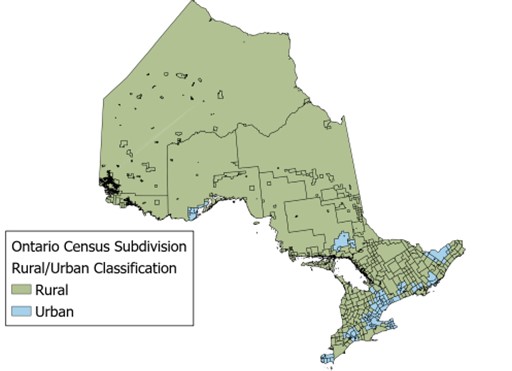What is Rural?
It is challenging to define what rural means. However, classifying areas as rural can be useful when gathering data and presenting information for decision making, statistical reporting, and advocacy.
Common approaches for selecting rural criteria are usually based on variations of population size, population density, and proximity to urban areas. These approaches reflect the continuum of rural which ranges from very rural to very urban. The two key dimensions of this continuum are the population of a community and how far a community is from an urban area (Figure 1). Rural communities are generally smaller and further away from the services and amenities of an urban area, such as health care, social assistance, education, and employment.

Figure 1. Dimensions along the rural continuum.
For data analysis and mapping purposes, ROI has adapted the Statistics Canada approach for Statistical Area Classification. The Statistics Canada approach is based on population and commuting patterns, which reflects both dimensions of the rural continuum. Large cities with a population greater than 100,000 and surrounding municipalities within commuting distance are classified as census metropolitan areas. Statistics Canada classifies smaller cities with at least 10,000 people and surrounding municipalities within commuting distance as census agglomerations. All other municipalities are classified by the level of influence from nearby census metropolitan areas or census agglomerations.
ROI considers any municipality within a census metropolitan area to be urban. Any municipality outside of a census metropolitan area is rural. This classification considers all large cities as the same, given their shared urban characteristics. It also considers smaller cities, small towns, and rural areas as the same. ROI acknowledges that there are limitations to this approach and that differences exist within these groups. However, this approach is helpful because it allows us to derive meaning from a large dataset and examine the differences between rural and urban statistics.
Rural – any municipality outside of census metropolitan areas.
Urban – any municipality within a census metropolitan area.
No single classification can adequately represent the unique characteristics of each municipality across Ontario. ROI is monitoring the ongoing conversation about the limitations and implications of rural classifications. As such, ROI is exploring other approaches for rural classification that may be useful for our stakeholders. Moving forward, some ROI publications may include other rural classifications. ROI data products will clearly explain which rural classifications were used in our analysis.
See the map below for an overview of rural classifications. For more information and an interactive map, go to the Geographies Dashboard.

Map of urban and rural municipalities in Ontario.